Study on the Wear Modes of PVD Films Using Different Concentrations of Al2O3 Abrasive Particles and Textured Rotating Balls
Abstract
1. Introduction
2. Materials and Methods
2.1. Material
2.1.1. Substrates and Balls Used in the Experiments
2.1.2. Abrasive Particles Characterization
2.2. Methods
2.2.1. Coating Deposition Process
2.2.2. Morphology and Thickness Analysis of the Coating
2.2.3. Roughness Analysis—AFM and 3D Profilometry
2.2.4. Adhesion Analysis
2.2.5. XRD Analysis
2.2.6. Nano-Hardness Assessment
2.2.7. Micro-Abrasion Test
3. Results and Discussion
3.1. Coatings Morphology and Thickness
3.2. Roughness Results
3.3. Adhesion Evaluation
3.4. Coating’s Structure
3.5. Nano-Hardness
3.6. Micro-Abrasion Analysis
3.7. SEM Balls Analysis
4. Concluding Remarks
- -
- Increasing the abrasive concentration reduced the specific wear rate of the film as it promoted a grooving wear mechanism; this mechanism is less effective in removing material when compared to the mix rolling/grooving mode detected in the condition tested with lower abrasive concentration.
- -
- The roughness of the ball (due to the chemical attack) combined with the increase in the abrasive concentration promoted the formation of a grooving wear mechanism; this is because there are more particles available and more aggregation of particles in the ball which scratch the specimen surface.
- -
- The test duration promoted more defined craters; this is because the grooving wear mode increased, as well as due to a greater wear volume.
- -
- Contrary to what is reported in the literature, which suggests that increasing the abrasive concentration of particles preferentially promotes rolling, when balls with induced roughness were used, grooving was preferentially promoted.
Supplementary Materials
Author Contributions
Funding
Institutional Review Board Statement
Informed Consent Statement
Data Availability Statement
Acknowledgments
Conflicts of Interest
References
- Martinho, R.P.; Silva, F.J.G.; Martins, C.; Lopes, H. Comparative study of PVD and CVD cutting tools performance in milling of duplex stainless steel. Int. J. Adv. Manuf. Technol. 2019, 102, 2423–2439. [Google Scholar] [CrossRef]
- Sousa, V.F.; Silva, F.; Alexandre, R.; Fecheira, J. Study of the wear behaviour of TiAlSiN and TiAlN PVD coated tools on milling operations of pre-hardened tool steel. Wear 2021, 476, 203695. [Google Scholar] [CrossRef]
- Silva, F.; Martinho, R.; Andrade, M.; Baptista, A.; Alexandre, R. Improving the Wear Resistance of Moulds for the Injection of Glass Fibre–Reinforced Plastics Using PVD Coatings: A Comparative Study. Coatings 2017, 7, 28. [Google Scholar] [CrossRef]
- Rutherford, K.; Hutchings, I. A micro-abrasive wear test, with particular application to coated systems. Surf. Coat. Technol. 1996, 79, 231–239. [Google Scholar] [CrossRef]
- Petersen; Link, R.; Rutherford, K.; Hutchings, I. Theory and Application of a Micro-Scale Abrasive Wear Test. J. Test. Eval. 1997, 25, 250. [Google Scholar] [CrossRef]
- Baptista, A.; Pinto, G.; Silva, F.; Ferreira, A.; Pinto, A.; Sousa, V. Wear Characterization of Chromium PVD Coatings on Polymeric Substrate for Automotive Optical Components. Coatings 2021, 11, 555. [Google Scholar] [CrossRef]
- Buchanan, F.; Shipway, P. Microabrasion—A simple method to assess surface degradation of UHMWPE following sterilisation and ageing. Biomaterials 2002, 23, 93–100. [Google Scholar] [CrossRef]
- Gee, M.; Gant, A.; Hutchings, I.; Bethke, R.; Schiffman, K.; Van Acker, K.; Poulat, S.; Gachon, Y.; von Stebut, J. Progress towards standardisation of ball cratering. Wear 2003, 255, 1–13. [Google Scholar] [CrossRef]
- Gee, M.; Gant, A.; Hutchings, I.; Kusano, Y.; Schiffman, K.; Van Acker, K.; Poulat, S.; Gachon, Y.; von Stebut, J.; Hatto, P.; et al. Results from an interlaboratory exercise to validate the micro-scale abrasion test. Wear 2005, 259, 27–35. [Google Scholar] [CrossRef]
- Schiffmann, K.; Bethke, R.; Kristen, N. Analysis of perforating and non-perforating micro-scale abrasion tests on coated substrates. Surf. Coat. Technol. 2005, 200, 2348–2357. [Google Scholar] [CrossRef]
- Kusano, Y.; Van Acker, K.; Hutchings, I. Methods of data analysis for the micro-scale abrasion test on coated substrates. Surf. Coat. Technol. 2004, 183, 312–327. [Google Scholar] [CrossRef]
- Cozza, R.C. Influence of the normal force, abrasive slurry concentration and abrasive wear modes on the coefficient of friction in ball-cratering wear tests. Tribol. Int. 2014, 70, 52–62. [Google Scholar] [CrossRef]
- Batista, J.; Joseph, M.; Godoy, C.; Matthews, A. Micro-abrasion wear testing of PVD TiN coatings on untreated and plasma nitrided AISI H13 steel. Wear 2002, 249, 971–979. [Google Scholar] [CrossRef]
- Silva, F.J.G.; Casais, R.B.; Martinho, R.P.; Baptista, A.P.M. Role of abrasive material on micro-abrasion wear tests. Wear 2011, 271, 2632–2639. [Google Scholar] [CrossRef]
- Ardila, M.; Costa, H.; de Mello, J. Influence of the ball material on friction and wear in microabrasion tests. Wear 2020, 450-451, 203266. [Google Scholar] [CrossRef]
- Pinto, G.; Baptista, A.; Silva, F.; Porteiro, J.; Míguez, J.; Alexandre, R. Study on the Influence of the Ball Material on Abrasive Particles’ Dynamics in Ball-Cratering Thin Coatings Wear Tests. Materials 2021, 14, 668. [Google Scholar] [CrossRef]
- Baptista, A.; Silva, F.; Pinto, G.; Porteiro, J.; Míguez, J.; Alexandre, R.; Sousa, V. Influence of the ball surface texture in the dragging of abrasive particles on micro-abrasion wear tests. Wear 2021, 476, 203730. [Google Scholar] [CrossRef]
- Ardila, M.; Costa, H.; de Mello, J. Topographic evolution of balls used in microabrasion tests. Wear 2021, 476, 203582. [Google Scholar] [CrossRef]
- Esteves, P.; de Macêdo, M.; Souza, R.; Scandian, C. Effect of ball rotation speed on wear coefficient and particle behavior in micro-abrasive wear tests. Wear 2019, 426–427, 137–141. [Google Scholar] [CrossRef]
- Stack, M.; Mathew, M. Mapping the micro-abrasion resistance of WC/Co based coatings in aqueous conditions. Surf. Coat. Technol. 2004, 183, 337–346. [Google Scholar] [CrossRef]
- Silva, F.J.G.; Fernandes, A.J.S.; Costa, F.M.; Teixeira, V.; Baptista, A.P.M.; Pereira, E. Tribological behaviour of CVD diamond films on steel substrates. Wear 2003, 255, 846–853. [Google Scholar] [CrossRef]
- Silva, F.G.; Neto, M.A.; Fernandes AJ, S.; Costa, F.M.; Oliveira, F.J.; Silva, R.F. Adhesion and Wear B haviour of NCD Coatings on Si3N4 by Micro-Abrasion Tests. J. Nanosci. Nanotechnol. 2009, 9, 3938–3943. [Google Scholar] [CrossRef] [PubMed]
- Rodríguez-Castro, G.; Reséndiz-Calderon, C.; Jiménez-Tinoco, L.; Meneses-Amador, A.; Gallardo-Hernández, E.; Campos-Silva, I. Micro-abrasive wear resistance of CoB/Co2B coatings formed in CoCrMo alloy. Surf. Coat. Technol. 2015, 284, 258–263. [Google Scholar] [CrossRef]
- Cozza, R.C. A study on friction coefficient and wear coefficient of coated systems submitted to micro-scale abrasion tests. Surf. Coat. Technol. 2013, 215, 224–233. [Google Scholar] [CrossRef]
- Silva, F.J.G.; Martinho, R.P.; Alexandre, R.J.D.; Baptista, A.P.M. Wear Resistance of TiAlSiN Thin Coatings. J. Nanosci. Nanotechnol. 2012, 12, 9094–9101. [Google Scholar] [CrossRef]
- Martinho, R.; Andrade, M.; Silva, F.; Alexandre, R.; Baptista, A. Micro-abrasion wear behaviour of TiAlCrSiN nanostructured coatings. Wear 2009, 267, 1160–1165. [Google Scholar] [CrossRef]
- Silva, F.J.G.; Martinho, R.P.; Baptista, A.P.M. Characterization of laboratory and industrial CrN/CrCN/diamond-like carbon coatings. Thin Solid Films 2014, 550, 278–284. [Google Scholar] [CrossRef]
- Stachowiak, G.; Celliers, O. Ball-cratering abrasion tests of high-Cr white cast irons. Tribol. Int. 2005, 38, 1076–1087. [Google Scholar] [CrossRef]
- Moreira, A.B.V. Cast ferrous Alloys Reinforced with Structural Ceramics for Wear Resistance Applications. Ph.D. Thesis, Department of Metallurgical and Materials Engineering, Faculty of Engineering, University of Porto, Porto, Portugal, 2022. [Google Scholar]
- Bello, J.; Wood, R. Micro-abrasion of filled and unfilled polyamide 11 coatings. Wear 2005, 258, 294–302. [Google Scholar] [CrossRef]
- Fernandes, F.; Ramalho, A.; Loureiro, A.; Cavaleiro, A. Mapping the micro-abrasion resistance of a Ni-based coating deposited by PTA on gray cast iron. Wear 2012, 292–293, 151–158. [Google Scholar] [CrossRef]
- Wolfe, G.J. The role of hard coatings in carbide milling tools. J. Vac. Sci. Technol. A Vac. Surf. Film. 1986, 4, 2747–2754. [Google Scholar] [CrossRef]
- Oliver, W.C.; Pharr, G.M. An improved technique for determining hardness and elastic modulus using load and displacement sensing indentation experiments. J. Mater. Res. 1992, 7, 1564–1583. [Google Scholar] [CrossRef]
- Oliver, W.C.; Pharr, G.M. Measurement of hardness and elastic modulus by instrumented indentation: Advances in understanding and refinements to methodology. J. Mater. Res. 2004, 19, 3–20. [Google Scholar] [CrossRef]
- Miranda, J.C.; Ramalho, A.; Cavadas, S. Efeito da temperatura de revenido no comportamento tribologico do aço din 100Cr6. Cienc. Tecnol. Mater. 2006, 18, 35–42. [Google Scholar]
- Cozza, R.C.; Tanaka, D.K.; Souza, R.M. Friction coefficient and abrasive wear modes in ball-cratering tests conducted at constant normal force and constant pressure—Preliminary results. Wear 2009, 267, 61–70. [Google Scholar] [CrossRef]
- Kumar, S.; Maity, S.R.; Patnaik, L. Effect of heat treatment and TiN coating on AISI O1 cold work tool steel. Mater. Today Proc. 2020, 26, 685–688. [Google Scholar] [CrossRef]

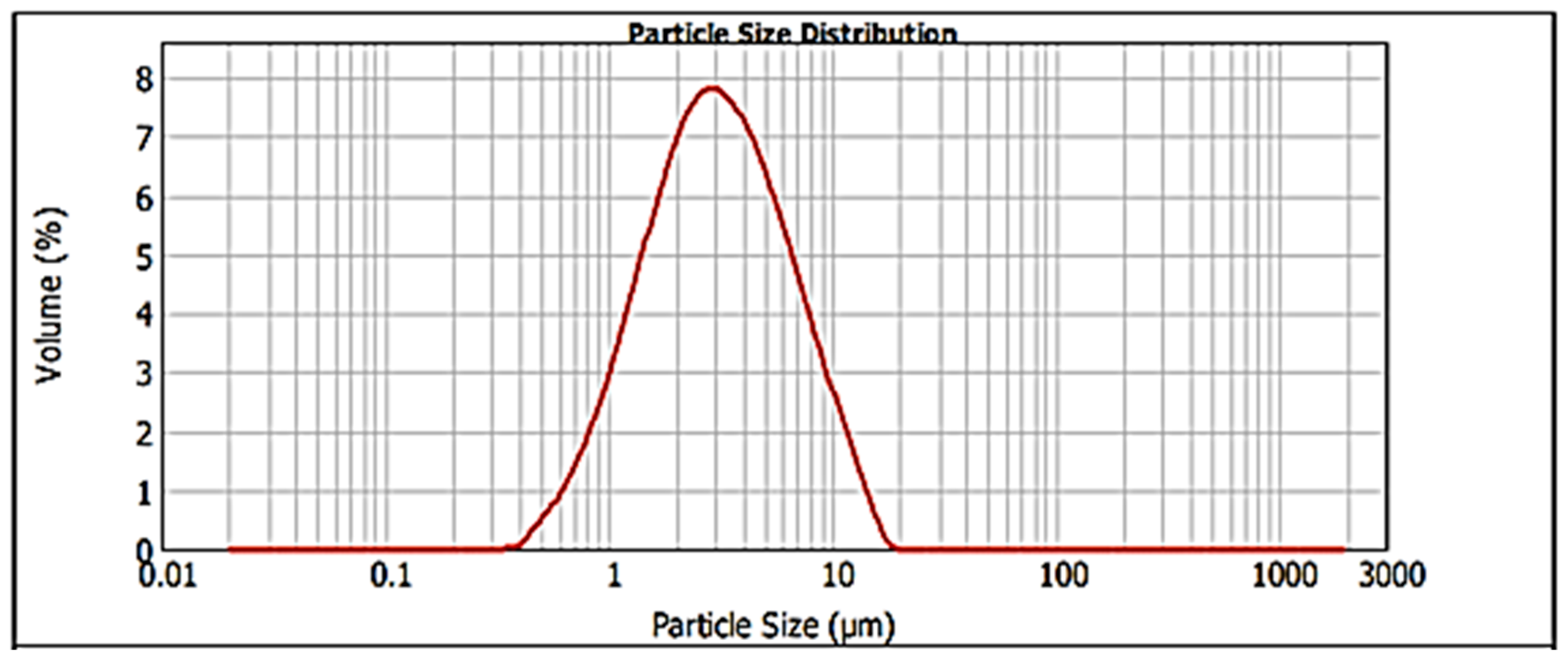
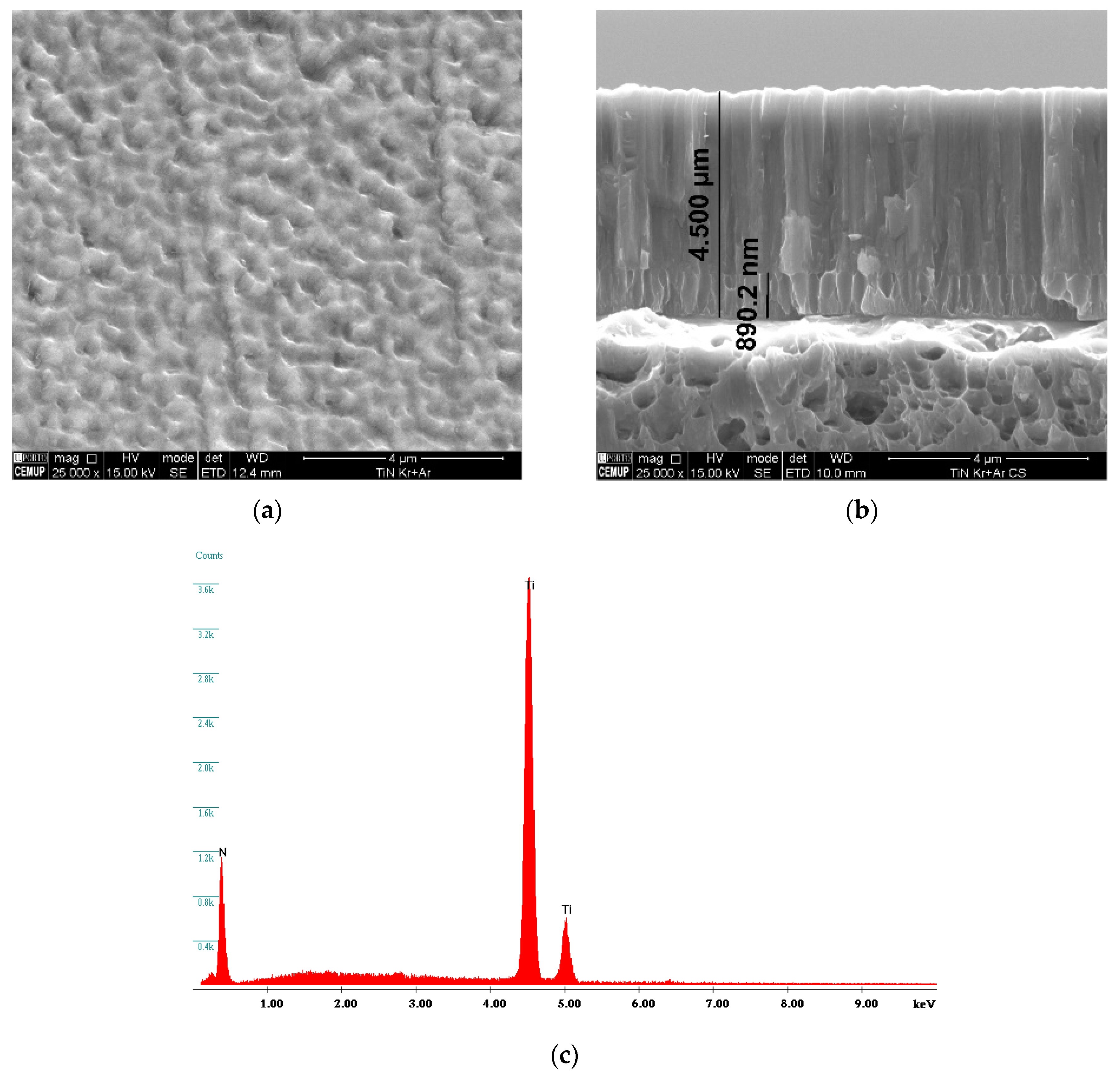


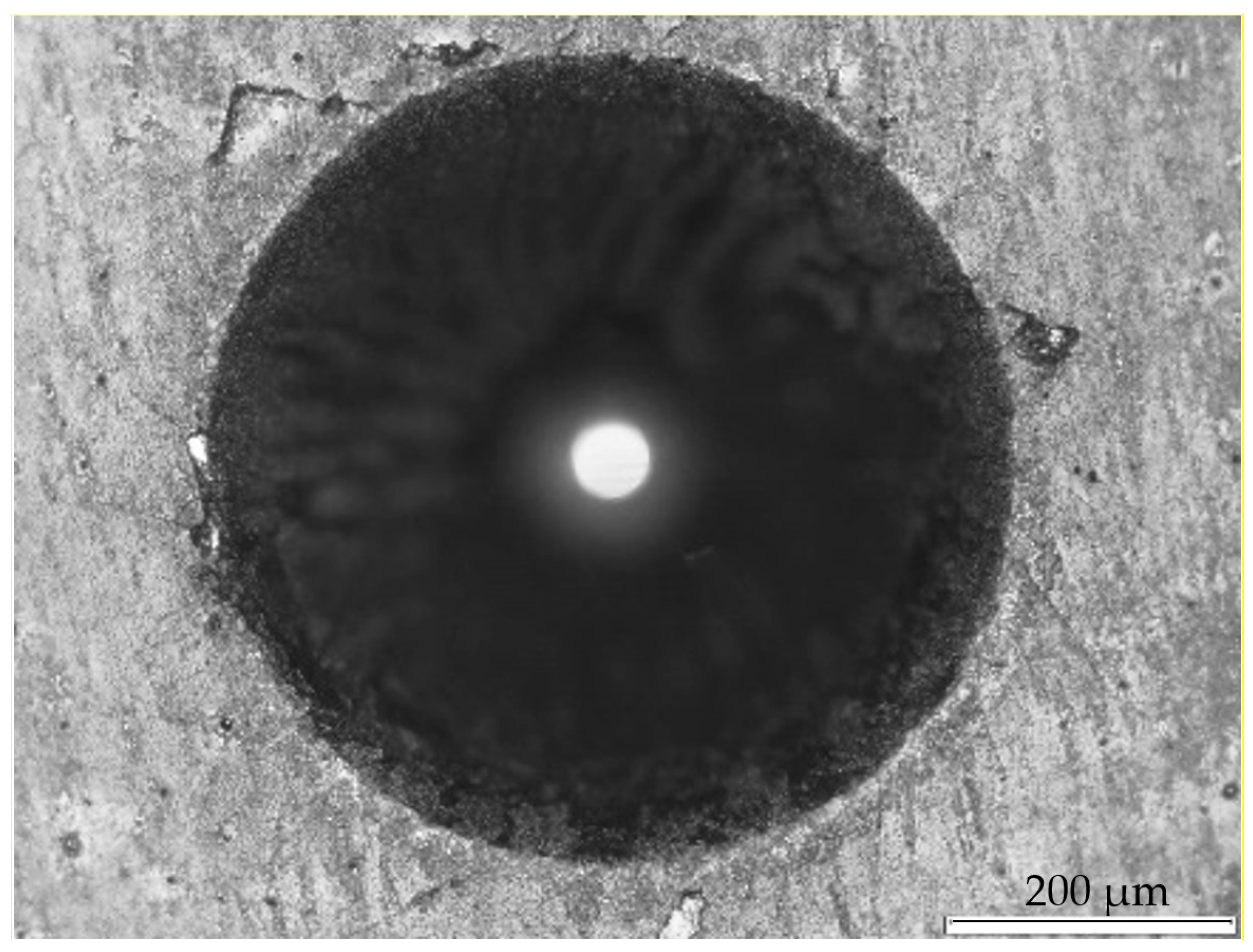
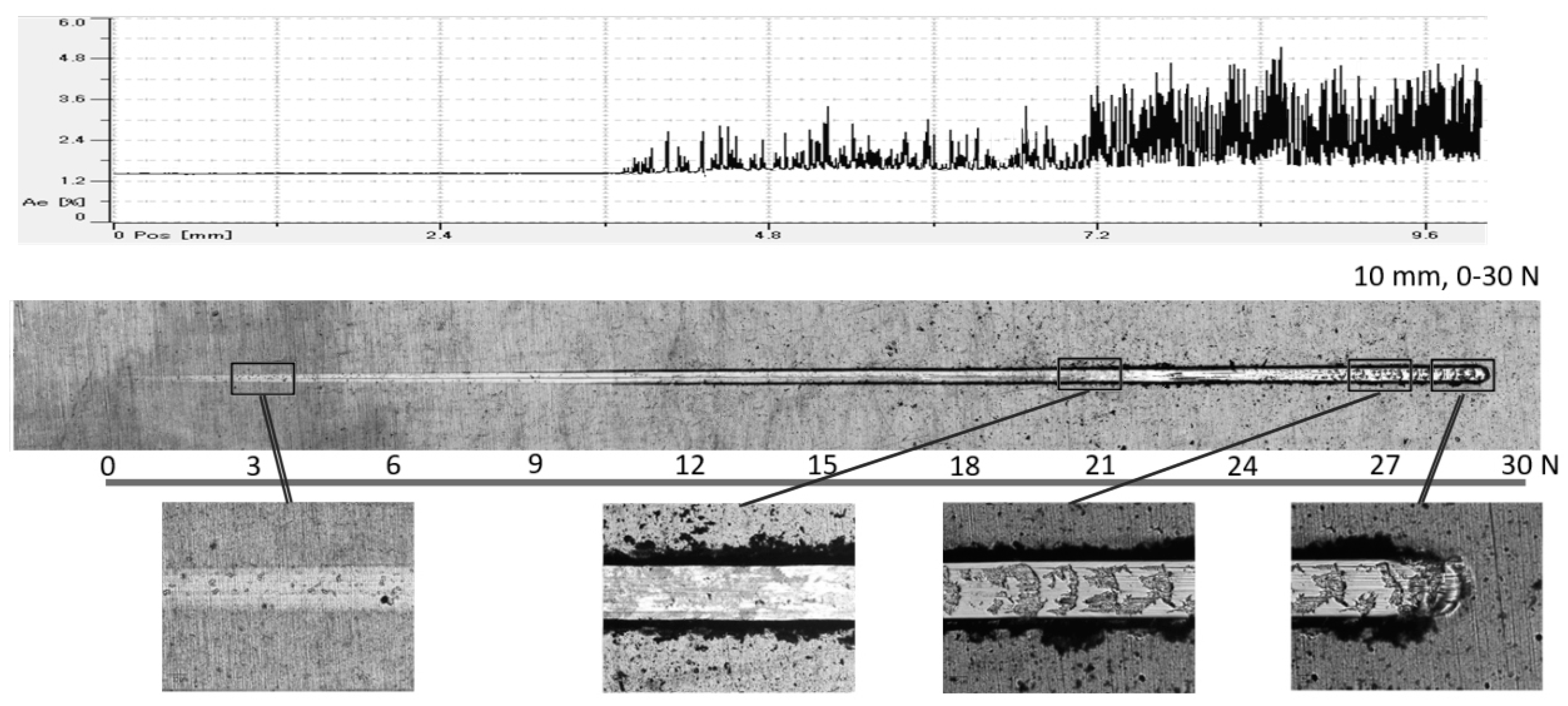
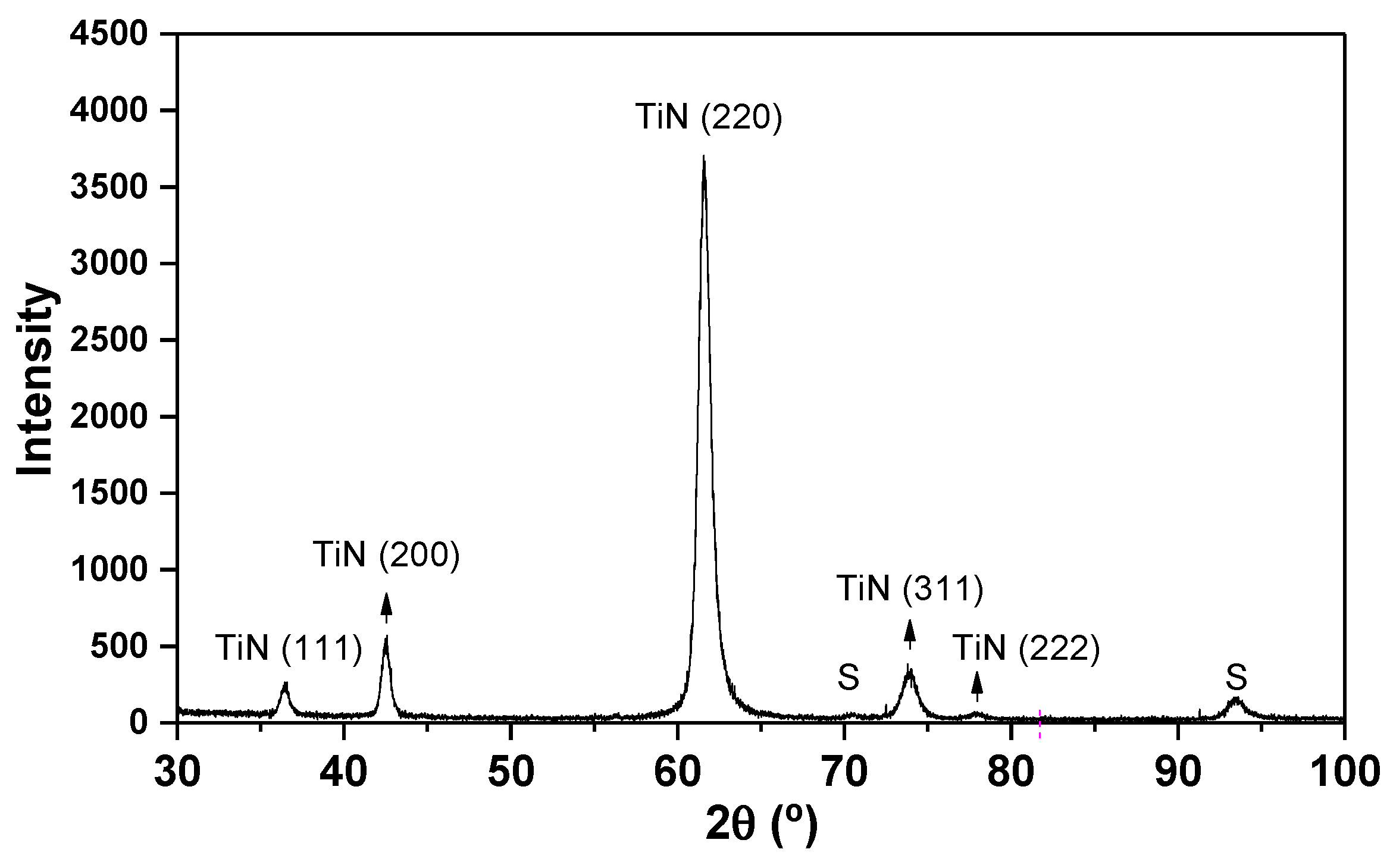


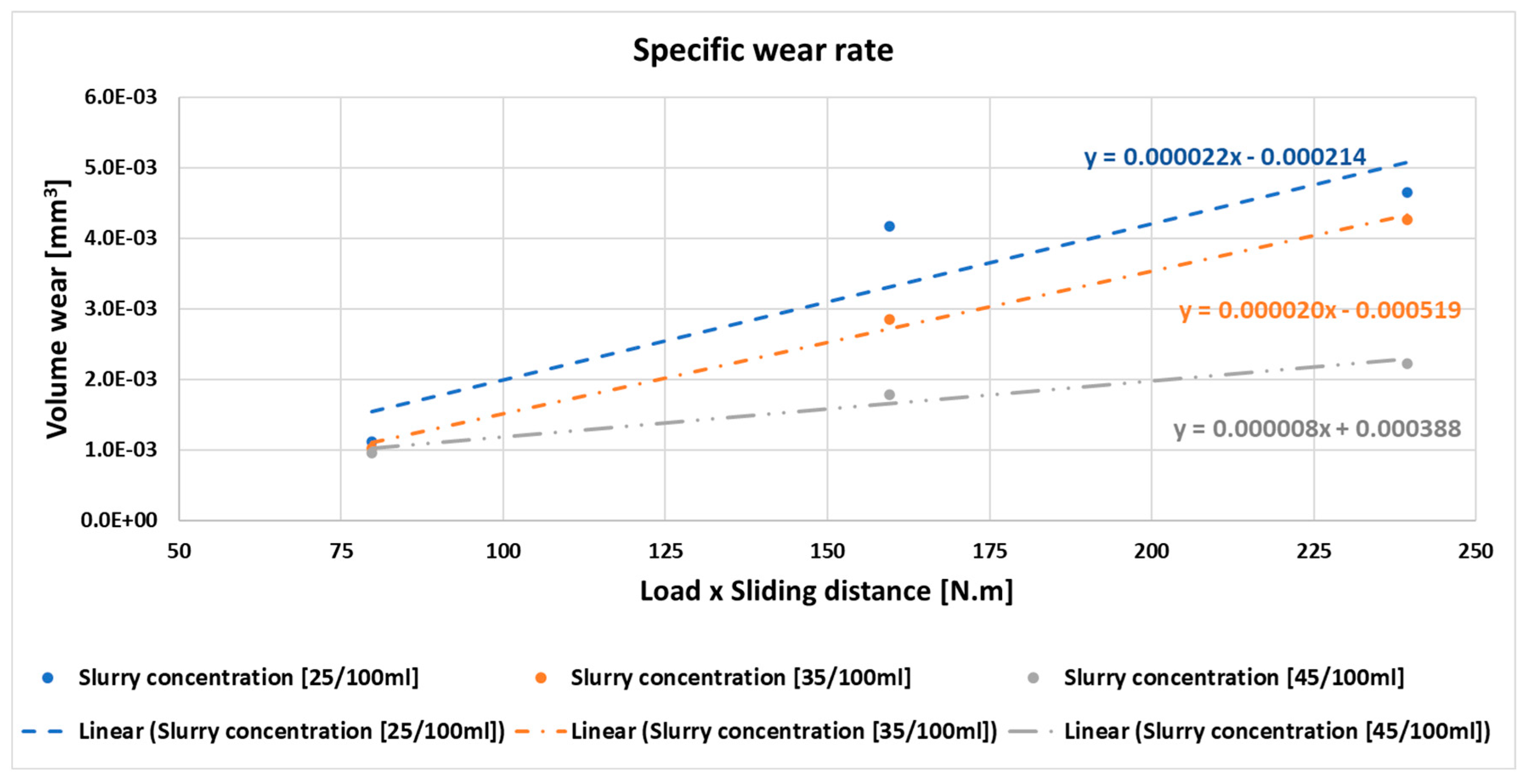
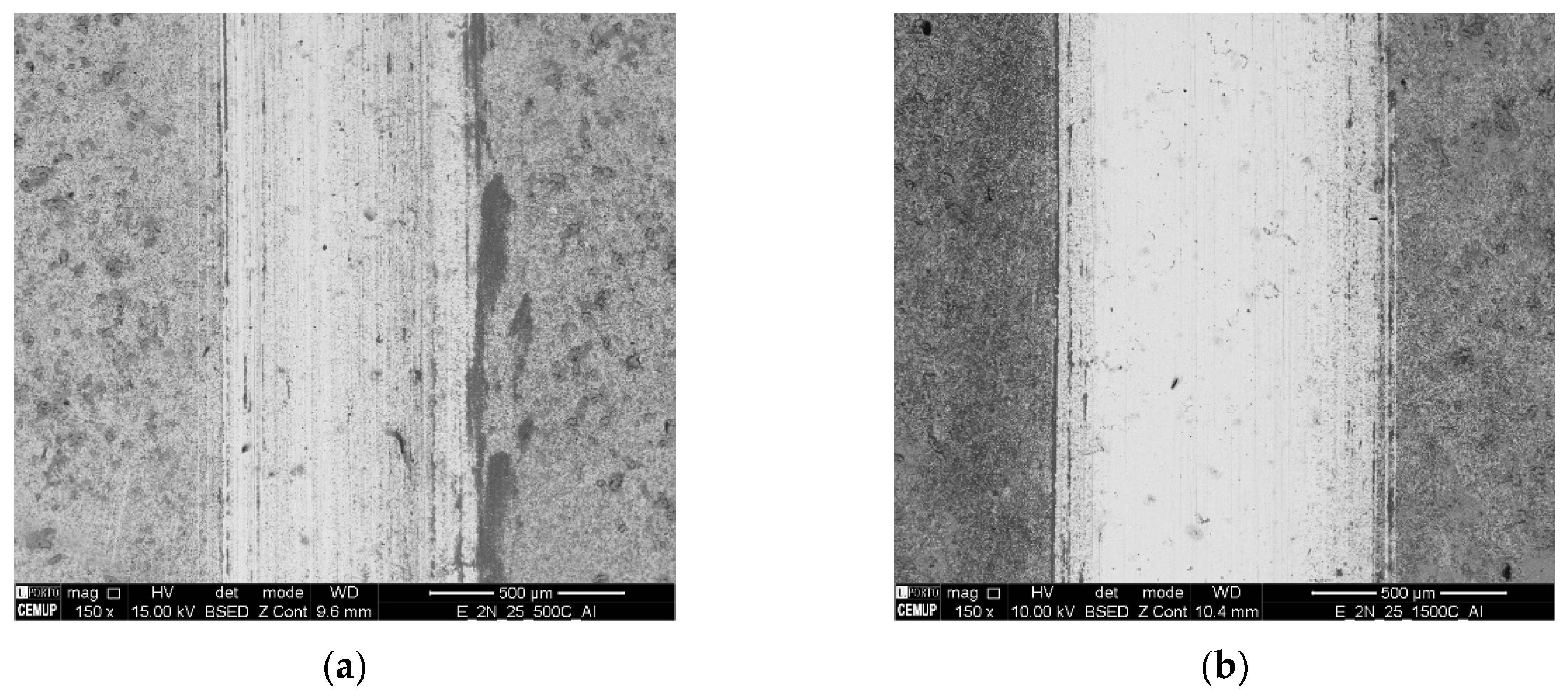
| C | Si | Mn | Cr | Mo | V |
|---|---|---|---|---|---|
| 0.6 | 0.35 | 0.8 | 4.5 | 0.5 | 0.2 |
| Deposition Parameters | Values |
|---|---|
| Temperature [K] | 750 |
| Gas pressure [Pa] | 0.650 |
| Bias range [V] | −105 to −90 |
| Rotation speed of the holder [rpm] | 1 |
| Target current [A] | 10 |
| Deposition time [min] | 120 |
| Tests Number | Concentration [g/100 mL] | Cycles [Rotation] | Sliding Distance [m] |
|---|---|---|---|
| 1 | 25 | 500 | 39.9 |
| 2 | 1000 | 79.8 | |
| 3 | 1500 | 119.7 | |
| 4 | 35 | 500 | 39.9 |
| 5 | 1000 | 79.8 | |
| 6 | 1500 | 119.7 | |
| 7 | 45 | 500 | 39.9 |
| 8 | 1000 | 79.8 | |
| 9 | 1500 | 119.7 |
| Tests Number | Concentration [g/100 mL] | Number of Cycles | Sa 50× [μm] | Sz 50× [μm] |
|---|---|---|---|---|
| 1 | 25 | 500 | 0.3544 | 2.0810 |
| 2 | 25 | 1000 | 0.3158 | 2.2539 |
| 3 | 25 | 1500 | 0.2892 | 1.9645 |
| 4 | 35 | 500 | 0.4259 | 3.1506 |
| 5 | 35 | 1000 | 0.2834 | 1.7717 |
| 6 | 35 | 1500 | 0.4949 | 3.5059 |
| 7 | 45 | 500 | 0.3546 | 2.0869 |
| 8 | 45 | 1000 | 0.2949 | 5.7062 |
| 9 | 45 | 1500 | 0.3982 | 2.4335 |
| Abrasive Particles Concentration [g/100 mL] | Cycles | Crater Average Diameter [mm] ± σ | S–Sliding Distance [m] | V–Volume Loss [mm3] ± σ | K–Specific Wear Rate [mm3/Nm] ± σ |
|---|---|---|---|---|---|
| 25 | 500 | 7.33 × 10−1 ± 8.1 × 10−4 | 39.90 | 1.12 × 10−3 ± 9.1 × 10−5 | 2.2 × 10−5 ± 2.4 × 10−6 |
| 1000 | 1.019 ± 1.0 × 10−3 | 79.80 | 4.17 × 10−3 ± 1.1 × 10−4 | ||
| 1500 | 1.047 ± 1.0× 10−3 | 119.69 | 4.64 × 10−3 ± 1.9 × 10−4 | ||
| 35 | 500 | 7.19 × 10−1 ± 8.0 × 10−4 | 39.90 | 1.03 × 10−3 ± 6.2 × 10−5 | 2.0 × 10−5 ± 2.9 × 10−6 |
| 1000 | 9.27 × 10−1 ± 1.1 × 10−3 | 79.80 | 2.85 × 10−3 ± 9.4 × 10−5 | ||
| 1500 | 1.025 ± 7.6 × 10−4 | 119.69 | 4.27 × 10−3 ± 5.8 × 10−5 | ||
| 45 | 500 | 7.06 × 10−1 ± 1.2 × 10−3 | 39.90 | 9.60 × 10−4 ± 9.8 × 10−5 | 8.0 × 10−6 ± 1.2 × 10−7 |
| 1000 | 8.25 × 10−1 ± 1.1 × 10−3 | 79.80 | 1.79× 10−3 ± 1.1 × 10−4 | ||
| 1500 | 8.72 × 10−1 ± 8.7× 10−4 | 119.69 | 2.23× 10−3 ± 1.1 × 10−4 |
Disclaimer/Publisher’s Note: The statements, opinions and data contained in all publications are solely those of the individual author(s) and contributor(s) and not of MDPI and/or the editor(s). MDPI and/or the editor(s) disclaim responsibility for any injury to people or property resulting from any ideas, methods, instructions or products referred to in the content. |
© 2023 by the authors. Licensee MDPI, Basel, Switzerland. This article is an open access article distributed under the terms and conditions of the Creative Commons Attribution (CC BY) license (https://creativecommons.org/licenses/by/4.0/).
Share and Cite
Pinto, G.F.; Baptista, A.; Sousa, V.F.C.; Silva, F.J.G.; Evaristo, M.; Fernandes, F. Study on the Wear Modes of PVD Films Using Different Concentrations of Al2O3 Abrasive Particles and Textured Rotating Balls. Coatings 2023, 13, 628. https://doi.org/10.3390/coatings13030628
Pinto GF, Baptista A, Sousa VFC, Silva FJG, Evaristo M, Fernandes F. Study on the Wear Modes of PVD Films Using Different Concentrations of Al2O3 Abrasive Particles and Textured Rotating Balls. Coatings. 2023; 13(3):628. https://doi.org/10.3390/coatings13030628
Chicago/Turabian StylePinto, Gustavo Filipe, Andresa Baptista, Vitor F. C. Sousa, Francisco J. G. Silva, Manuel Evaristo, and Filipe Fernandes. 2023. "Study on the Wear Modes of PVD Films Using Different Concentrations of Al2O3 Abrasive Particles and Textured Rotating Balls" Coatings 13, no. 3: 628. https://doi.org/10.3390/coatings13030628
APA StylePinto, G. F., Baptista, A., Sousa, V. F. C., Silva, F. J. G., Evaristo, M., & Fernandes, F. (2023). Study on the Wear Modes of PVD Films Using Different Concentrations of Al2O3 Abrasive Particles and Textured Rotating Balls. Coatings, 13(3), 628. https://doi.org/10.3390/coatings13030628











